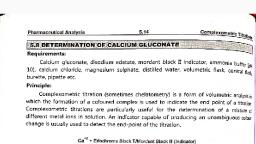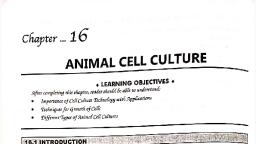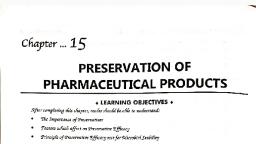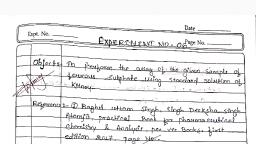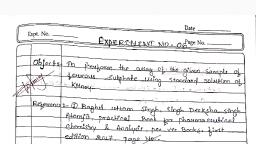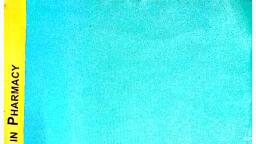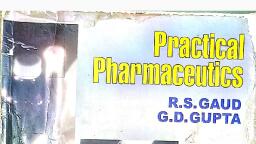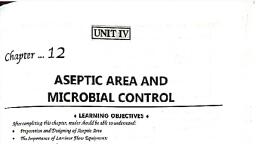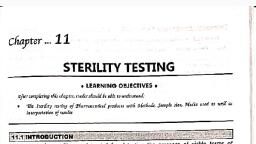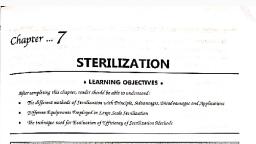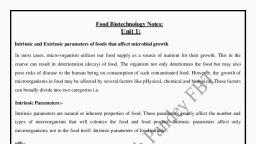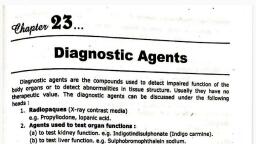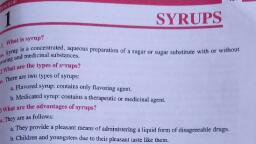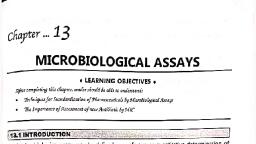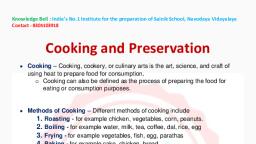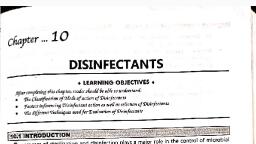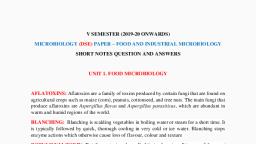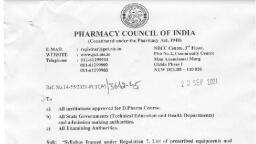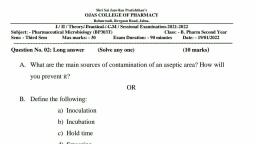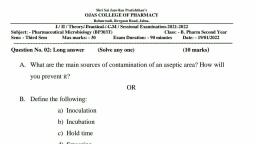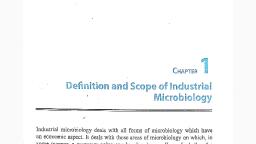Page 1 :
Chapter ... 14, MICROBIAL SPOILAGE, , ¢ LEARNING OBJECTIVES «, After completing this chapter, reader should be able to understand:, , © The Microbial Spoilage and its Types, © = The Factors affecting on Microbial Spoilage, , , , © Sources and Types of Microbial Contamination, © — Assessment of Microbial Contamination with reference to Non-Sterile Pharmaceuticals, , , , , , , , 44.1 INTRODUCTION ©, , , , Microorganisms form an integral part of our environment. They are present in the air,, food, soil, water etc. Different types of microorganisms mainly contaminate the, pharmaceutical preparations and spoil it. Such spoilage results in major health problems to, the users and financial problems for the manufacturer due to the loss of product o, expensive litigation with aggrieved users of the medicine. In injections, eye drops and certain, dressings, sterility is essential since any contaminants may cause infections and the products, of contaminants (pyrogens) may cause harmful and even lethal reactions, Oral and topic?!, preparations may cause infections after microbial contamination, the most serious incidert, being the occurrence of the typhoid fever by the ingestion of contaminated thyroid tablets, Excessive microbial contamination may cause more or less extensive deterioration of tht, product. |, , Pharmaceutical products may be considered to be microbiologically spoiled if low ., of pathogenic microbes or toxic microbial metabolites are present and detectable phys, or chemical changes have occured in the Product., , ‘ er “en if, Microbial limit standards for non-sterile pharmaceutical dosage forms are Ln, specific monographs in different pharmacopoeias. A list of raw materials and vet, products mainly tested for microbiological qualities as per Indian Pharmacopoeia is give, , Table 14.1., (14.1)
Page 3 :
Pharmaceutical Microbiology (B.Pharm. Sem. 0) 14.3 Microbial Spoitage, , The amount of water in the formulation is one of the important factors, mainly, considered in establishing the need for microbial standards. Pharmaceutical Products have, the potential to support microbial growth in the presence of water. Microbial limits for, capsules and tablets are generally applied to those of plant, animal or mineral origins. The, susceptibility of particular products to microbial growth and damage is dependent upon the, nature of formulation. Tablets containing natural drugs have higher microbial count as, compare to synthetic drugs. Most microbial species are Gram-positive, spore forming and, mould type. Oral formulation contaminated by micro-organisms mainly cause, gastrointestinal disorders e.g. Salmonelta typhi. External semi-solid preparations applied on, skin, provide the opportunity for Staphylococcus and Pseudomonas and produce localized, infections. These topical products should be free from Staphylococcus aureus and, , Pseudomonas aeruginosa., , 14.2 TYPES OF MICROBIAL SPOILAGE, , 1. Infection induced by contaminated pharmaceutical products:, Pharmaceutical products may be contaminated by pathogenic microorganisms mainly, , from raw materials or at the time of preparations. These contaminated pharmaceuticals may, , cause serious infections to the patients when they use these drugs or formulations. Cholera, , in a West African country was traced to an oral liquid drug which had been prepared with, , contaminated water. Recently, several children died in the UK from septicaemia caused by, , Pseudomonas contamination of parenteral nutritional fluids during their aseptic preparation., , Different dosage forms and contaminated microorganisms which are responsible for, , diseases are given in Table 14.2., , , , , , , , , , Table 14.2: Contaminating micro-organisms and their infections, , , , , , , , , , , , Dosage forms Contaminating microbes Infections, Tablet/capsules Salmonelia species Salmonella infection, Eye drops Pseudomonas aeruginosa Eye infections, Antiseptic solutions Pseudomonas species Septicemia, Ointments and creams Gram-negative bacteria Dermatoses and burns, Intravenous medicines Candida species Fatal septicemia, , , , , , 2. Physical and chemical deterioration of products:, , Pharmaceutical formulations may be considered as specialised micro-environments, Some naturally occurring ingredients are Particularly sensitive to attack. Crude vegetable, and animal drug extracts often contain wide assortments of microbial nutrients besides thé, therapeutic agents. The rate of deterioration of ingredients depend upon its chemic2l, structure, physico-chemical properties of a particular environment and the level of microb®!, , contamination present.
Page 4 :
Fr, , ns emaceutical Microbiology (B.Pharm.Sem.1) 14.4, , Microbial Spoilage., ; observable effects of microbial attack on products: ,, , Microbial spoilage of different dosage forms may be detected by organoleptic tests., these spoiled products may release very unpleasant smelling and tasting metabolities such, qs ‘sour’ fatty acids, ‘fishy’ amines, ‘earthy’ or sickly tastes and smells. Formulations may, become coloured green, pink, brown, black or yellow by diffusible microbial pigments., spoiled creams by microbial attack may become lumpy or gritty. Degradation of surfactant, and lowering of pH by lipase attack of triglycerides induces progressive coalescence of lipid, droplets and eventually complete separation of the two phases. Surface activity is reduced at, very early stage in the metabolism of most surfactants. Thickening and suspending agents, produces marked reduction in viscosity by depolymerisation., , 4. Ingredients susceptible to microbial attack:, , (i) Therapeutic agents: Laboratory experiments have demonstrated that many drugs, are capable of gross degradation by a wide variety of microorganisms. Potent therapeutic, agents such as analgesics (aspirin, paracetamol), alkaloids (morphine, atropine), barbiturates,, steroid esteres etc. can be metabolised and serve as substrates for microbial growth. Aspirin, may be converted to salicyclic acid and penicillin (by B - lactamase) or chloramphenicol (by, chloramphenicol acetylase) to inactive products. Localised transformation of steroids has, been observed around fungal colonies growing on the surface of steroid tablets and in, steroidal creams. Many microbial transformations are useful for production of potent, steroids,, , (ii) Surface active agents: Alkali-metal and amine soaps of fatty acids (anionic, surfactants) are generally stable due to the slightly alkaline pH of the formulations, which is, easily degraded in sewage. Alkyl and alkylbenzene sulphonates and sulphate esters are, metabolised by w-oxidation of their terminal methyl groups followed by sequential, B-oxidation of the alkyl chains and fission of the aromatic rings. The cationic surfactants, used as antiseptics and preservatives in pharmacy are slowly degraded at high dilution in, sewage. Alkylpolyoxyethylene alcohol emulsifiers (non-ionic surfactants) are readily, metabolised by a wide variety of microorganisms. Microbial resistance may be observed by, increasing chain length and branching of emulsifiers. Ampholytic surfactants such as, Phosphatides, betaines and alkylamino-substituted amino acids are important group of, surfactants and are reasonably biodegradable., , (iii) Polymers and humectants: Thickening and suspending agents used in pharmacy, are subjected to microbial depolymerisation by extracellular enzymes yielding nutritive, fragments and manomers e.g. starch (amylases), pectin (pectinases), dextran (dextranases),, Protein (proteases), carboxymethyl cellulose (cellulases) and tragacanth (uronidases)., Polyethylene glycols are readily degraded by sequential oxidation of the hydrocarbon chains, but agar (complex polysaccharides) is a relatively inert polymer. Polymers used in plastic, Packaging are extremely resistant to microbial attack. Glycerol and sorbitol (humectants) in, Pharmaceuticals readily support microbial growth unless present in high concentration.
Page 5 :
Mic: 7, Pharmaceutical Microbiology (B.Pharm. Sem. Ii) 14.5 Toblal Spoiiage, , (iv) Fats and oils: Fats and oils (hydrophobic substances) are usually attackey, extensively when dispersed in aqueous formulations such as oil-in-water emulsions. Funge|, growth is reported in condensed moisture films on the surface of bulk oils or if water, droplets contaminate the bulk phase during storage. Lipolytic breakdown of trigyceride,, liberates glycerol and fatty acids, then by B-oxidation of the alkyl chain Produces Cdouroys, ketones. The microbial metabolism of hydrocarbon oils presents a considerable problem in, engineering and fuel technology when water is present as a contaminant., , (v) Preservatives and disinfectants: Most organic preservatives and disinfectants are, metabolised readily by many bacteria and fungi and may serve as growth substrates at, concentrations below their effective ‘use’ levels. Organomercurial preservatives discharged, into rivers from paper mills have been extensively converted to toxic alkyl Mercury, compounds which could reach humans via an ascending food chain. Degradation of agents, at required concentrations in different dosage forms is less commonly reported,, Pseudomonas species have metabolised 4-hydroxybenzoate ester preservatives contained in, eye drops and caused serious eye infections. Many disinfectants shows growth of, microorganisms if these chemicals are in dilute form. a, , (vi) Sweetening, flavouring and colouring agents: Many sugars and other sweetening, agents used in pharmacy are ready substrates for microbial growth. However, some are used, in very high concentrations to reduce water activity in aqueous products and inhibit, microbial attack. Aqueous stock solutions of flavouring agents such as peppermint water, , and chloroform water and colouring agents such as amaranth or tartrazine readily support, rowth of bacteria and yeasts., , 14.3 FACTORS AFFECTING MICROBIAL SPOILAGE, , The Physical and chemical status of a pharmaceutical formulation influences the type, and extent of microbial spoilage considerably. A specific combination of conditions within a, product may favour its degradation by a particular group of microorganisms., , (i) Size of innoculum: Low levels of contaminants may be present in a product but it, would cause low rates of, , , , , , , , , , Y suggest a greater risk th taining high, numbers of fungal and bacterial spores. ° eee .

